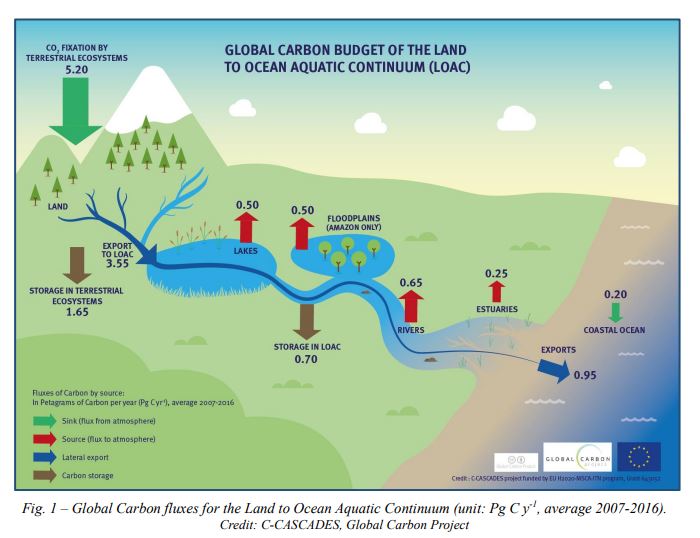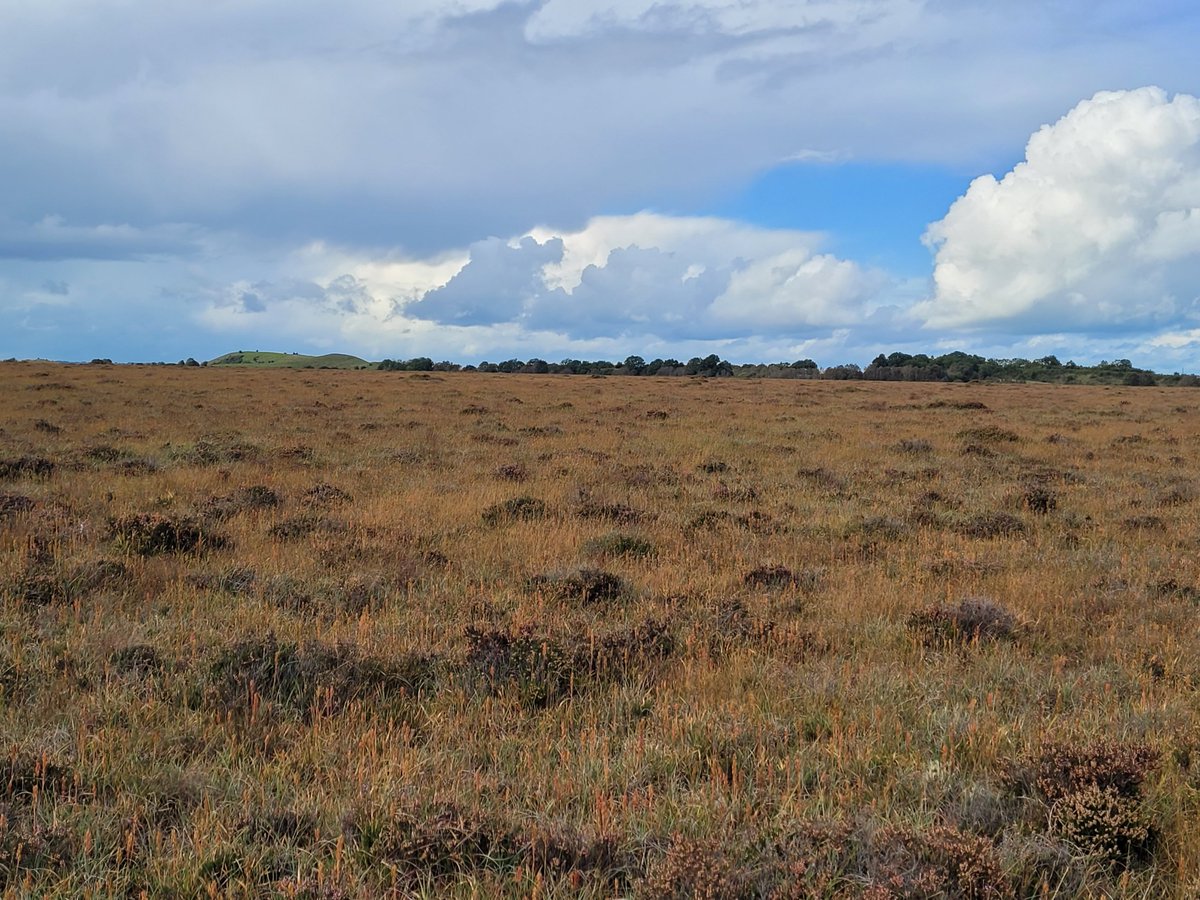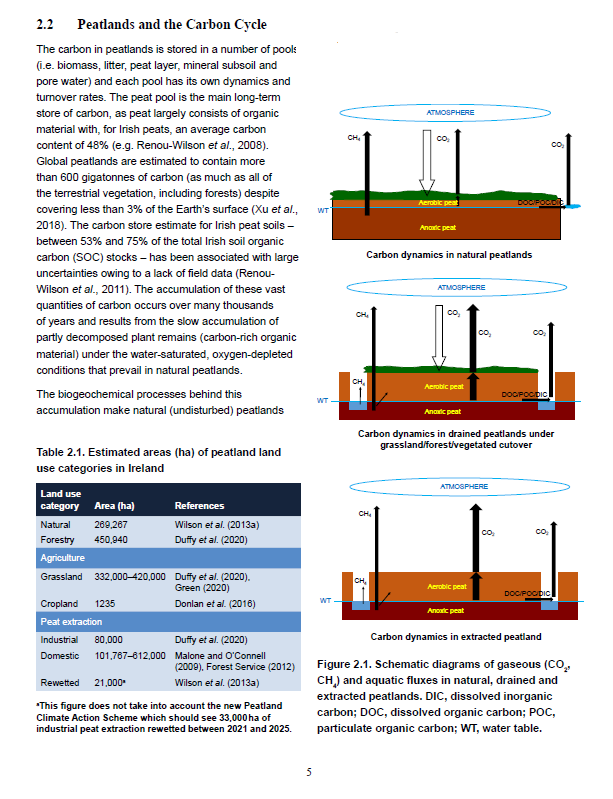
1. Wednesdays 🧵thanks for your patience. Had a busy day 😐. Hope this is worth the wait. Today, we are going to talk about the Burrishoole population of Salmo salar, the mighty Atlantic salmon
📽️Ger Rogan
📽️Ger Rogan
2. From the outset, we are talking about Atlantic salmon today (Salmo salar) and not any of the Pacific salmon species (various Oncorhynchus sp.). 1 of these species is making in-roads into this side of the Atlantic (the PINK salmon), but that’s a whole other story 

3. Why do salmon receive so much attention, in comparison to other fish species? @SteveOrmerod put it very well:
https://twitter.com/SteveOrmerod/status/1580925625967443968?s=20&t=Am3FtRYNSOXN2jxG0_yiXg
4. To get a full appreciation of how awesome salmon are, we should consider where they live and their complex life cycle. Their native range extends from Spain to Greenland....
#AtlanticSalmon
(Source: commons.wikimedia.org/wiki/File:Dist…)
#AtlanticSalmon
(Source: commons.wikimedia.org/wiki/File:Dist…)

5. ...and lifespan depends mainly how far north they live, but roughly, they spend a couple of years in freshwater and 1 or 2 years in the sea. Infographic from @MarineInst (with thanks to @ElizabethRyder7 and @Kaksweeney )🙂 

6. Overall lifetime survival of salmon is low. Freshwater survival (egg to smolt) is about 1% and marine survival (smolt to adult) is about 8%. 3000 eggs (or ova) might produce 30 smolts after 2 years, and of those 30 smolts, 2 might survive to be spawning adults
🖼️@MarineInst
🖼️@MarineInst

7. Not great odds! Apart from natural mortality (predation, disease, food constraints, floods etc) there are so many other human-related (anthropogenic) things out to get them. Text book definition of #MultipleStressors 😟 

8. There are 140 salmon rivers in Ireland (give or take). Stock assessment for these rivers falls under the remit of @InlandFisherIE and @Dept_ECC, using advice from the multi-agency group TEGOS fisheriesireland.ie/what-we-do/res… .
9. Salmon regulations for each year (how many rivers are open for fishing, and how many fish may be caught) are based on these stock assessments carried out by TEGOS @InlandFisherIE fisheriesireland.ie/sites/default/…
10. This stock assessment is based on the number of adults returning to spawn. About 30 rivers have electronic fish counters and 2 rivers (Erriff & Burrishoole) have traps on them, where the fish are physically counted 🐟🐟🐟🎣🎣
fisheriesireland.ie/what-we-do/res…
fisheriesireland.ie/what-we-do/res…
11. I gave you some background to the Burrishoole traps earlier this week, so now lets take a look at the trends that we see over 7 decades .....
https://twitter.com/IrelandsEnviro/status/1584497126205030400?s=20&t=V0Z-BLMXjTVzuCBW2gjH0A
12. Salmon return to Burrishoole as either 1SW or MSW fish. A 1SW fish (called a grilse) goes to sea as a smolt around May, spends a winter at sea & returns in the summer of the next year. They are smaller than MSWs as they spend less time in the rich feeding grounds of the ocean 

13.In contrast, a #MSW fish will spend Multiple Winters at Sea (usually 2 for Irish fish), and will return a little earlier than the #1SW, in the springtime. This is why they are sometimes called #spring fish or a #springer. They are bigger than 1SW fish 

14. Of the 140 salmon rivers in Ireland, some are known for their springers and those rivers tend to have big estuaries or deep lakes where these early returning fish can hang out for the summer @TomEReed @uccBEES cdnsciencepub.com/doi/abs/10.113…
15. We used to have quite a lot of MSW fish in Burrishoole. In the 1950s, draft net catches of salmon in L. Furnace were reported to be 25 % MSW, when during the fishing season (only a couple of months), 120 MSW and 500 grilse were recorded in a year. Info from this book 👇 

here come the graphs....
(reminds me of a comment from @AKWALisette that most people dont like graphs as much as we (scientists) do 😂
#SorryNotSorry
(reminds me of a comment from @AKWALisette that most people dont like graphs as much as we (scientists) do 😂
#SorryNotSorry
16. Since 1970 (when our full census started), MSW fish have averaged <5% of the total run and has numbered less than 20 in recent years. This is almost certainly the result of #overfishing in the mid 1900s but as we don’t have much data pre-1959, its hard to be certain 
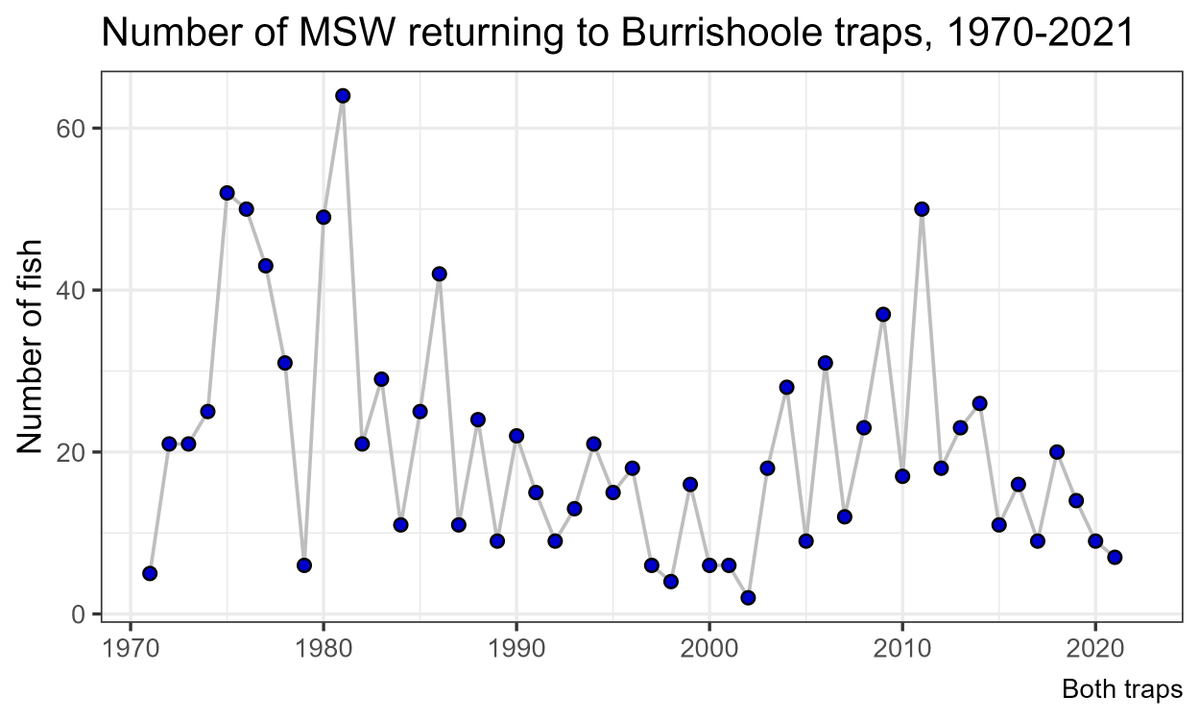
17. The Burrishoole salmon population is therefore predominantly a grilse run, with fish returning over the summer, and spending up to 6 months in Lough Feeagh and its rivers. They don’t eat during this time, but just bide their time until spawning time, which is around 🎄🎅
18. Grilse have decreased over the 50+ years we have data for. The period of the 1970s was considered a productive salmon decade generally, and since then, numbers have steadily declined (tks @hildug for lovely graph code 🙏) 

@hildug 19. Our freshwater survival averages 0.75%
i.e. for every 1000 eggs spawned, 75 will survive to smolt age and migrate to sea
i.e. for every 1000 eggs spawned, 75 will survive to smolt age and migrate to sea

20. FW survival has increased recently, as hatchery fish have not been allowed to spawn in the wild since the late 1990s. This was a management decision based on the increasing weight of genetic evidence that #stocking rivers with #hatchery fish is 👎👎royalsocietypublishing.org/doi/full/10.10…
21. Marine survival looks like it has also been fairly steady over the years, averaging 7.9% when measured as the number of fish returning to freshwater
i.e for every 1000 smolts going to sea, ~79 adults will return to spawn
HOWEVER…
i.e for every 1000 smolts going to sea, ~79 adults will return to spawn
HOWEVER…
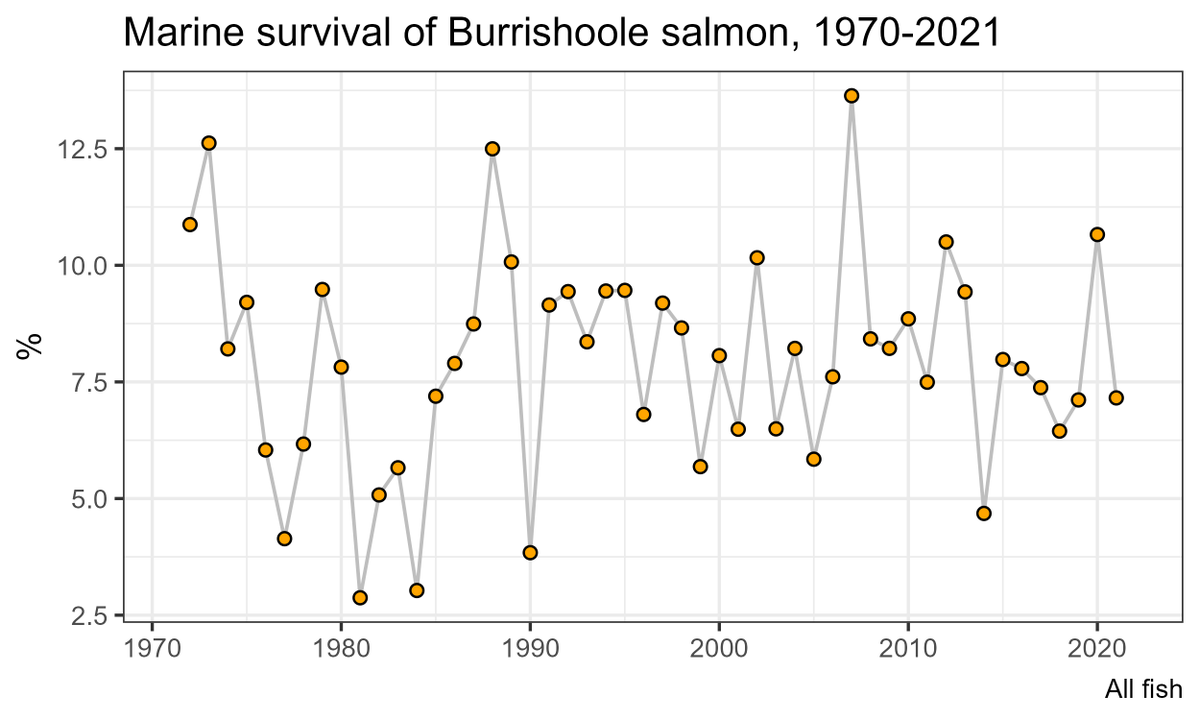
22. We know that between the 1980s and the early 2000s, the salmon fishery off the 🇮🇪 coast was catching between 60% and 80% of 🐟🐟returning to our homewaters, right up until 2007, when that fishery was closed. When we correct marine survival for that, we get a different picture 

23. As well as fewer fish making it home, the fish that do make it are smaller each year, decreasing from 62 cm to 57 cm recently. This may not seem much, but the number of eggs a female salmon carries is related to size.
Less eggs per fish, as well as less fish overall 🙄
Less eggs per fish, as well as less fish overall 🙄

24. The last really big change we see is that the timing of the return of salmon is getting tighter every decade. In the 70s, a lot of fish came back well into October, while in the last couple of years, we rarely get fish after mid September.
#Phenology
#SalmonMigration
#Phenology
#SalmonMigration

25. When we take all this together, (the earlier return of salmon, reduced marine survival and decreasing body size) we must conclude that there are considerable oceanic challenges for this species
26. As we saw earlier, there are probably multiple reasons for this decline, and there is a huge international ongoing effort to try and figure it out. This table of hypotheses is from the @SalmonAlliance @AST_Salmon
missingsalmonalliance.org/key-mortality-…
missingsalmonalliance.org/key-mortality-…
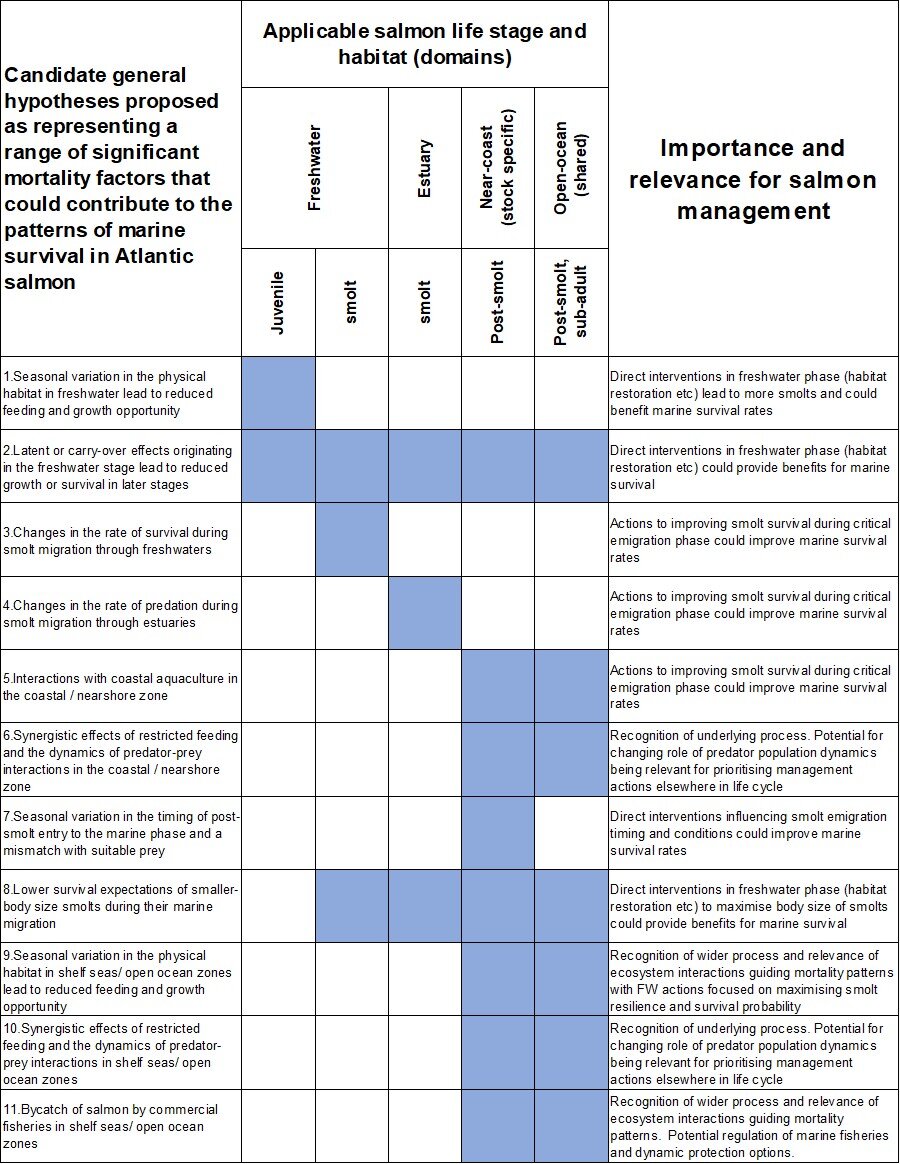
27. Progress is being made into quantifying these impacts. One massive step forward is that in the last couple of years, the location of marine feeding grounds has been narrowed down e.g. this paper from John Gilbey onlinelibrary.wiley.com/doi/full/10.11…
28. Some of the impacts are going to be hard to address e.g #ClimateChange impacts (which are undoubtedly an issue) can only be addressed by the global implementation of the #ParisAgreement and its successors....
(bonus 🐻gif - couldnt resist)
(bonus 🐻gif - couldnt resist)
29. Saving the salmon seems like a daunting prospect in the face of these global challenges. Nevertheless, where there is #Life, there is #Hope, and while we still have returning salmon in many rivers, we still have a chance. And we still do have lots of them.......
@NASCO_Sec
@NASCO_Sec
@NASCO_Sec 30. I'll leave it there, because its late. For those of you who haven’t read the @StreamScapes Salmon Sanctuaries booklet, HAVE a LOOK. It is FANTASTIC and a nice bit of night time reading
Tomorrow, I think we are on to trout…….
streamscapes.ie/wp-content/upl…
Tomorrow, I think we are on to trout…….
streamscapes.ie/wp-content/upl…
• • •
Missing some Tweet in this thread? You can try to
force a refresh





